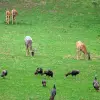Why You Should Add Perrenial Food Plots To Your Deer Hunting Property
Planting perennials now will keep deer coming back to your property year after year

Food plots are becoming an annual ritual for the nation’s whitetail hunters and land managers, and the yearly conundrum of “what should I plant?” can be vastly simplified if you devote at least a portion of your food plot space to perennials; plant types that, once established, can be counted on to grow for several years with minimal maintenance.
Perennials offer several advantages for the food plotter. They give the soil a break from the grind of tilling, spraying, fertilizing, and liming associated with brassicas and other annuals. Perennials, especially clover and alfalfa, actually boost soil health due to their nitrogen-fixing nature. They also stabilize soil and prevent erosion. And of course, there’s a significant cost savings, especially in a year like this, in not having to make repeat trips to spray, till, and plant plots devoted to annuals.
Finally, there’s this; whitetails adore perennials. While they’re no miracle cure (perennials won’t be as attractive to deer in northern climes after late-fall frosts and snow nip them), deer absolutely crush perennial plots and return to them, even after being distracted by early fall soft mast crops and the annual acorn drop. One expert land manager I know devotes at least 70 percent of his substantial food plot space to perennials and admitted “If I didn’t live in the Midwest, where I need corn, soybeans, and brassicas to keep deer fed in late fall and winter, I might turn most everything I have over to clover.” So yeah, perennials are that good.
How to Grow Perennials Right
1) Choose Your Spot
Most perennials prefer a well-drained site that receives adequate to good sunlight (5-6 hours/day or more). While perennial plots can be established in small areas, like log landings and clearings, pay attention to large trees on the perimeter that can shade the plot. Unless they’re desirable timber or mast-producing species, consider dropping them to shed more sunlight on your plot.

2) Prep The Ground
Veteran food plotters chant “soil test” to near-annoying levels, but listen to their advice, which they get from the farmers; folks who really know how to grow stuff. Soil tests reveal the amount of lime and fertilizer your dirt will require and it’s wise to follow those directions. Acidic soils (common across most of the country) won’t let your plants flourish; lime will adjust the pH to more desirable levels and your perennials will thrive. Fertilizer gives plants the boost they need to compete with undesirable species and, even better, it helps them taste good to deer.
3) Take Care of Perrenials
The beauty of perennial plots is they tend to be low maintenance, but that doesn’t mean you can ignore them. Mowing is a critical part of maintaining a flourishing perennial plot; by clipping plots once or twice each summer (possibly more in warmer climes), you’ll not only keep your perennials in an aggressive, growing stage that’s more palatable to deer, you’ll discourage weed competition. Sometimes weeds are bad enough that spraying is required, but check with your seed company to see what chemicals your perennials will tolerate. Some innovative sprays that aren’t harmful to clover, alfalfa, etc. have been developed, but don’t assume yours is one until you know.
4) Spruce Up Your Perrenial Plot
Frost seeding can add vigor, not to mention longer life, to an established perennial plot. It’s also a good idea to soil test every year to see if your plot could benefit from additional lime and fertilizer, which can usually be applied (or top-dressed) to existing plants.
The Best Perennials Food Plots For Deer Hunters
1) Clover

Ray Scott knew what he was doing back in 1988, when he introduced Imperial Whitetail Clover and marketed it to deer hunters. While an ingenious salesman–he perfected the professional bass fishing tournament format–Scott wasn’t just pitching snake oil; whitetails not only adore clover, it’s actually good for them, chock-full of protein and other nutrients, as well as incredibly tasty to deer. IWC literally launched the food plot craze, and these days any food plot company worth its salt offers a clover variety.
Clover grows well in a variety of climates and is relatively easy to establish and maintain. Follow your seed maker’s recommendations, and planting a killer clover plot is just not that hard. And, with some return visits to clip the plot each summer, you’ll have a food source whitetails will adore from the first blush of summer to the snowfalls of late fall. Even better, some ingenious sprays to combat weed competition in clover have been developed, making this one of the no-brainer food plot offerings for deer hunters and land managers.
2) Alfalfa

While often viewed as the ugly cousin to clover, alfalfa is a killer food plot perennial. I live in farm country, and I can’t count how many seasons I’ve watched whitetails walk past virtually any food plot offering–including standing corn and soybeans in the late season–and paw through a foot of snow to feast on new-seeded alfalfa. So yeah, alfalfa is really that attractive to deer.
Alfalfa also boasts a deeper root system, which means it can grow in spots not conducive to clover and survive droughts that would kill its more tender cousin. On the downside, alfalfa is susceptible to fungi, insect, and other blights that can affect its long-term survival. So spraying alfalfa to combat these pests may be necessary, and staying in touch with your local elevator or farm supply store for maintaining alfalfa health is a good idea. Still, I firmly believe in diversity when it comes to food plot plantings, and alfalfa can be a vital addition to any food plot plans involving perennials.
3) Chicory

The relative “new kid on the block” when it comes to perennial food plot offerings, chicory should be on any food plotter’s shortlist. Indeed, in a study conducted by noted University of Tennessee whitetail biologist Craig Harper and noted on the National Deer Association site, “Nearly 60 percent of chicory was consumed by deer on low deer-density sites (which is the best situation for determining forage preference). In this category chicory ranked second only to soybeans among 20 of the most popular deer forages that included various clovers, cereal grains, brassicas, and cowpeas.”
In my experience, if your deer aren’t familiar with species like chicory, it can take an introduction period for them to figure out exactly how tasty it is. So prepare for a little “lag-time” before your whitetails roll up their sleeves and tear into chicory—once that happens, watch the heck out.
Read Next: The Best Trees (and Two Shrubs) for Deer Hunters to Plant
4) Mixes/blends

You don’t have to shop in the food plot section very long to realize that most seed makers bag up several seed types to be used in a single planting. One of my favorites is a clover/chicory blend that gives deer a chance to nibble on two perennials while feeding in the same plot. Given the fickle nature of feeding deer (not only do they have the attention span of a toddler when it comes to food, they’re also experts at knowing exactly what they need at a given time) this is important. Also, chicory and clover can be more palatable and attractive to deer at different times, so having both in the same plot gives it more staying power.
You can even mix annuals with perennials. My favorite way to establish a clover plot is to mix clover with cereal rye, an annual. The rye germinates and grows quickly, serving as a cover crop for the slower-growing clover. In addition to suppressing weed competition, the rye also prevents erosion, and deer love it. When the clover is mature enough to clip, the rye gets it too and is basically done with its job of helping the clover along. This tactic can work with other annual seeds as well.
